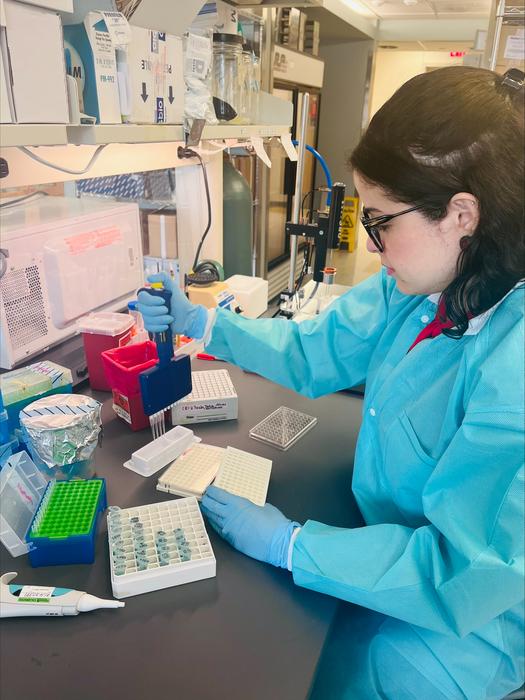A newly discovered Zika virus-specific synthetic molecule is capable of differentiating Zika-immune patient samples from samples of patients previously infected with the related dengue virus. The technology may lead to the development of better diagnostics and vaccine candidates, scientists announced today in the Proceedings of the National Academy of Sciences.

Credit: Amro Nasser, University of Pittsburgh
A newly discovered Zika virus-specific synthetic molecule is capable of differentiating Zika-immune patient samples from samples of patients previously infected with the related dengue virus. The technology may lead to the development of better diagnostics and vaccine candidates, scientists announced today in the Proceedings of the National Academy of Sciences.
The study, led by researchers at the University of Pittsburgh School of Public Health and The Herbert Wertheim UF Scripps Institute for Biomedical Innovation & Technology, is the first to apply an innovative “epitope surrogate” technology to Zika. Until now, researchers and clinicians have lacked diagnostic tools to easily differentiate between prior infections with different flaviviruses, a family of mostly mosquito- and tick-borne viruses that include Zika and dengue. This has posed challenges for clinical-epidemiologic studies, viral diagnostics and vaccine development.
“If you go to places like Brazil, nearly everybody is going to have some immunity to dengue, and also to Zika,” says first author Priscila Castanha, Ph.D., an assistant professor in the Department of Infectious Disease and Microbiology at Pitt Public Health. “This makes it very difficult to test new treatments or determine how widespread an emerging disease may be in areas endemic for flaviviruses, which cause a high burden of illness globally.”
Antibodies for Zika virus, a mosquito-borne virus that spread to the Americas in 2015 and still causes sporadic disease, can be confused in many diagnostic tests with antibodies for dengue virus, making it difficult to tell if someone who tests positive previously had dengue, Zika or both. It is especially important for reproductive-age women to know if they already had Zika – and likely have immunity – because infection during pregnancy can cause birth defects. Knowing if they have immunity or not could guide the extent of people’s efforts to avoid mosquitoes in endemic areas during pregnancy.
The research team used an approach pioneered by co-senior author Thomas Kodadek, Ph.D., a chemist with The Wertheim UF Scripps Institute to screen half a million “peptide-inspired conformationally constrained oligomers,” or PICCOs, against blood samples from people infected with dengue or Zika virus. The PICCOs are nonorganic molecular shapes hooked onto microscopic plastic beads. They mimic epitopes, which are the parts of a pathogen that an antibody would connect to in order to neutralize the threat.
If any of the PICCOs match the corresponding shape of an antibody in the blood sample, the antibody will hook onto them and researchers can “fish” it out. The presence of an antibody against a virus in someone’s blood means that they were previously infected with or vaccinated against that virus, prompting their immune system to produce antibodies.
“The technology is amazing. You don’t need to know the sequence, or the structure, or even the pathogen,” said co-senior author Donald Burke, M.D., Pitt Public Health dean emeritus. “As long as you have chosen the right sets of patient blood samples to compare, you can tease out the important antibodies that differ between the patient sets, along with the corresponding synthetic molecule biomarkers.”
The researchers identified 40 PICCOs that engaged Zika virus antibodies. After screening against dengue-positive blood, one PICCO, dubbed CZV1-1, was particularly good at hooking Zika antibodies, but not dengue. This single CZV1-1 PICCO synthetic molecule correctly identified people previously infected with Zika virus 85.3% of the time and only generated false positives in 1.6% of tests, rates comparable to COVID-19 antibody tests.
Castanha, Burke and co-senior author Ernesto T.A. Marques, M.D., Ph.D., associate professor in Pitt Public Health’s Department of Infectious Disease and Microbiology, have been studying Zika virus since it emerged in the Americas in 2015. Prior to its emergence in Brazil, Castanha, Marques and Burke were studying dengue virus.
“For every sample we tested during the 2015 outbreak, we had to do 10 different blood tests to confirm Zika,” said Castanha. “These tests are technically difficult and time-consuming, making them impractical for providing clinical guidance. I think if we had this molecule back then, it would’ve been fantastic.”
The ability for diagnostics to differentiate between flavivirus antibodies is important in clinical-epidemiological studies. Marques and Burke previously showed that for Zika virus and dengue virus, patient outcomes differ based on prior exposure, which poses challenges to prevention, diagnosis and care.
Importantly, the PICCO screening technology used to identify the Zika-specific molecule doesn’t require refrigeration and could also be used for other outbreaks.
“The molecule is a molecular mimic that cannot unfold,” Kodadek said. “That means there’s no cold chain required, making it particularly useful for outbreaks occurring in remote or low-resourced areas.”
Additional authors on this study are Patrick J. McEnaney, Ph.D., and Paige Dickson, Ph.D., both of The Wertheim UF Scripps Institute; Yongseok Park, Ph.D., Anthea Bouwer, Ph.D., and Jodi Craigo, Ph.D., all of Pitt; Elton Chaves, Ph.D., Roberto Lins, Ph.D., and Marli T. Cordeiro, M.D., all of Oswaldo Cruz Foundation in Brazil; Nicholas G. Paciaroni, Ph.D., and Graham Carlson, Ph.D., both of Deluge Biotechnologies in Florida; and Tereza Magalhães, Ph.D., of Texas A&M University and Universidade Federal da Bahia in Brazil.
This research was funded by a grant from the National Institute of Allergy and Infectious Diseases (R01AI127677).
Journal
Proceedings of the National Academy of Sciences



